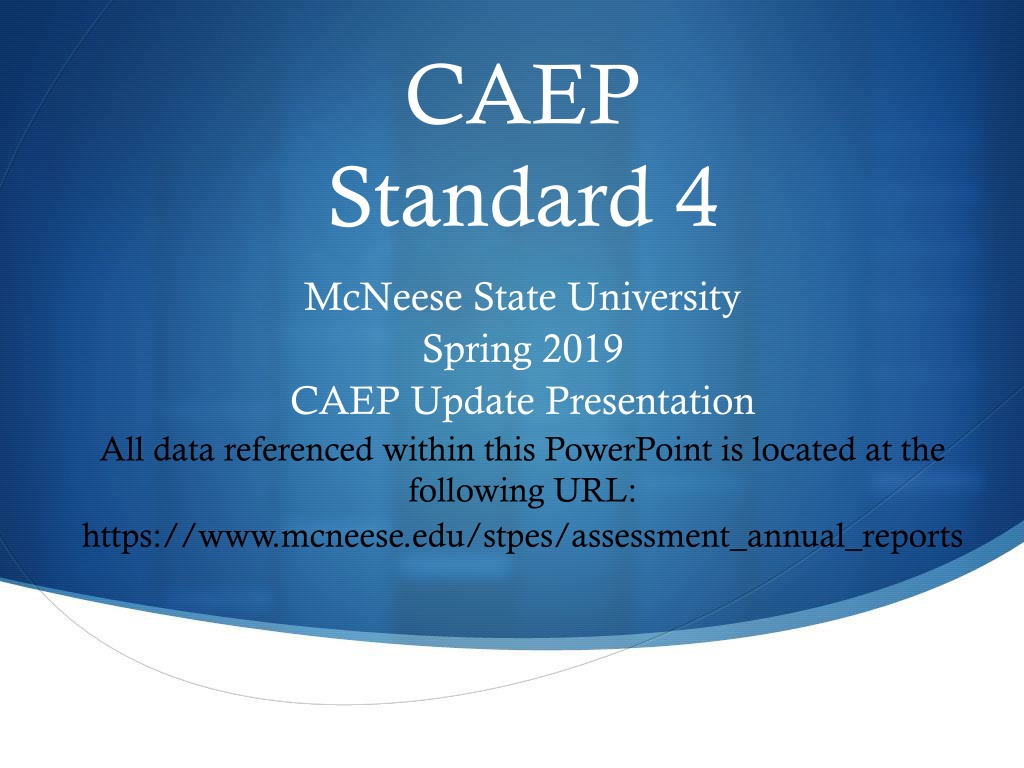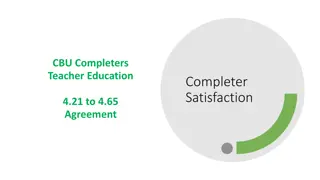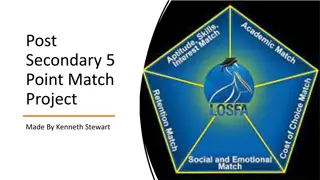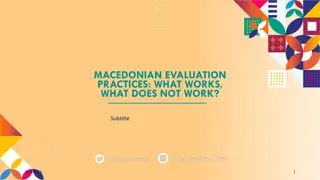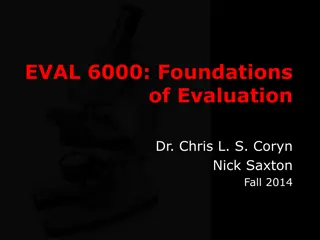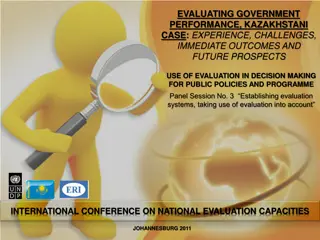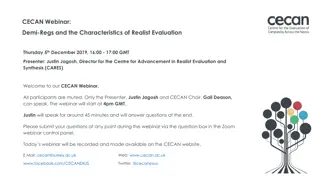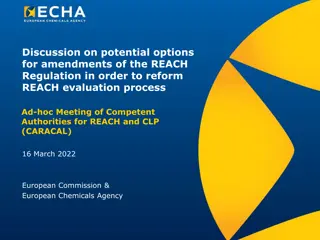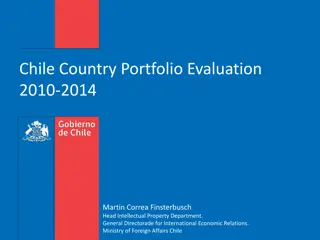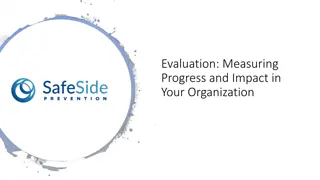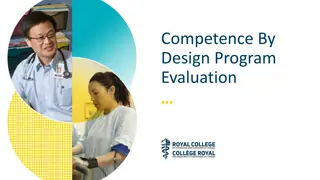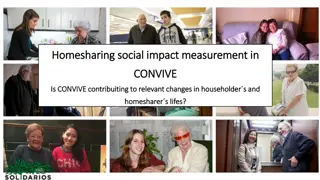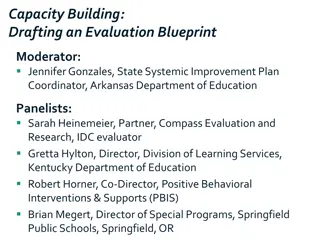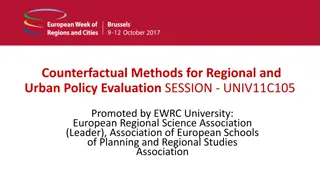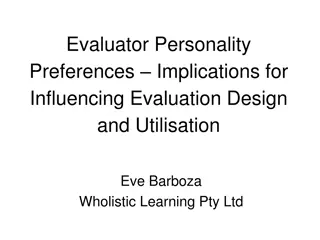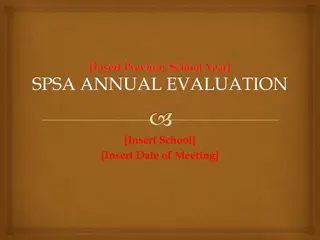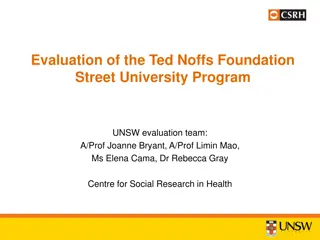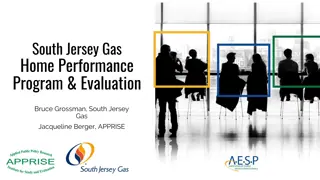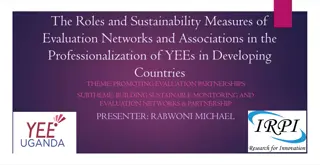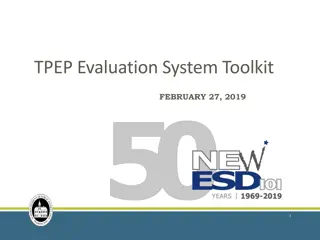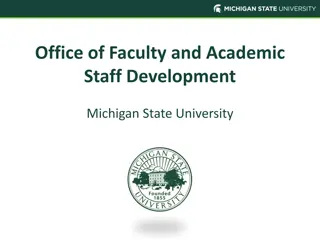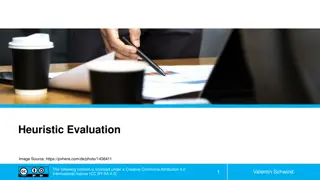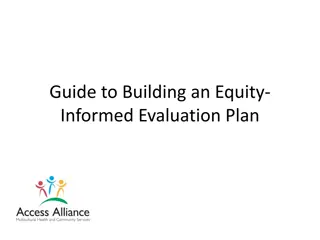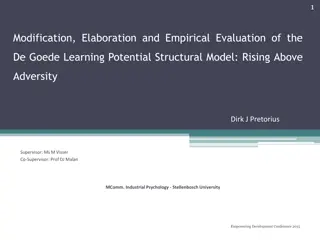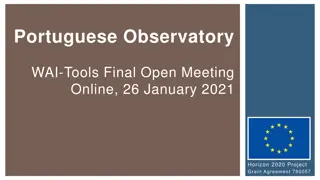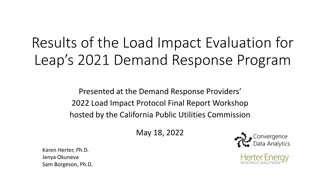Evaluation of Completers' Impact on P-12 Learning and Development at McNeese State University
This presentation from McNeese State University discusses the assessment and impact of completers on P-12 student learning, classroom instruction, and satisfaction with their preparation. It includes annual reporting measures, Louisiana Department of Education expectations, and data on program outcomes and consumer information. The content also covers InTASC standards and provides insights into graduate outcomes and student growth metrics.
Download Presentation

Please find below an Image/Link to download the presentation.
The content on the website is provided AS IS for your information and personal use only. It may not be sold, licensed, or shared on other websites without obtaining consent from the author. Download presentation by click this link. If you encounter any issues during the download, it is possible that the publisher has removed the file from their server.
E N D
Presentation Transcript
CAEP Standard 4 McNeese State University Spring 2019 CAEP Update Presentation All data referenced within this PowerPoint is located at the following URL: https://www.mcneese.edu/stpes/assessment_annual_reports
InTASC Standards The Learner and Learning Standard 1- Learner Development Standard 2- Learning Differences Standard 3- Learning Environments Content Knowledge Standard 4- Content Knowledge Standard 5- Application of Content Instructional Practice Standard 6- Assessment Standard 7- Planning for Instruction Standard 8- Instructional Strategies Professional Responsibility Standard 9- Professional Learning and Ethical Practice Standard 10- Leadership and Collaboration
Standard 4 The provider demonstrates the impact of its completers on P-12 student learning and development, classroom instruction, and schools, and the satisfaction of its completers with the relevance and effectiveness of their preparation.
8 Annual Reporting Measure Program Outcome and Consumer Information: Completer or graduation rates Licensure rate Employment rate Consumer information, including students loan default rate Program Impact: P-12 student learning/ development Observations of teaching effectiveness Employer satisfaction Completer persistence
Louisiana Department of Education Expectations Highly Effective: 4.0-3.5 Effective: Proficient: 3.49-2.5 Effective: Emerging: 2.49-1.5 Ineffective: 1.49-1.0
2018 Louisiana Fact Book and Data Dash Boards: Undergraduate Year Mean Number Ineffective Effective: Emerging Effective: Proficient Highly Effective Compass Student Growth (SLT/VAM) (CAEP 4.1) 3% 7% 1% 10% 1% 10% 2016 2017 2018 3.4 (n=446) 3.4 (n=422) 3.4 (n=360) 28% 23% 19% 63% 66% 70% Compass Professional Practice (Observation Evaluations) (CAEP 4.2) 3.2 (n=446) 1% 2016 8% 62% 30% 2017 2018 3.2 (n=422) 3.3 (n=360) 1% 1% 7% 6% 55% 48% 37% 45% Compass Final Evaluation (Average of two categories) 3% 6% 2% 7% 1% 7% 2016 2017 2018 3.3 (n=446) 3.4 (n=422) 3.4 (n=360) 51% 45% 38% 41% 46% 54%
2018 Louisiana Fact Book and Data Dash Boards: Master of Arts in Teaching (MAT) Year Mean Number Ineffective Effective: Emerging Effective: Proficient Highly Effective Compass Student Growth (SLT/VAM) (CAEP 4.1) 3% 6% 1% 6% 1% 8% 2016 2017 2018 3.4 (n=179) 3.5 (n=120) 3.6 (n=78) 27% 22% 15% 64% 72% 76% Compass Professional Practice (Observation Evaluations) (CAEP 4.2) 3.3 (n=179) 0% 2016 7% 51% 42% 2017 3.2 (n=120) 0% 8% 44% 48% 2018 3.4 (n=78) 0% 6% 37% 56% Compass Final Evaluation (Average of two categories) 3% 3% 2016 3.4 (n=179) 49% 45% 2017 3.5 (n=120) 1% 3% 43% 53% 2018 3.6 (n=78) 1% 3% 35% 62%
2018 Louisiana Fact Book and Data Dash Boards: Alternative Certification (PBC) Year Mean Number Ineffective Effective: Emerging Effective: Proficient Highly Effective Compass Student Growth (SLT/VAM) (CAEP 4.1) 1% 10% 2016 3.4 (n=105) 26% 64% 2017 2018 3.5 (n=84) 3.6 (n=80) 0% 0% 6% 4% 29% 25% 66% 71% Compass Professional Practice (Observation Evaluations) (CAEP 4.2) 3.3 (n=105) 0% 2016 6% 50% 45% 2017 2018 3.3 (n=84) 3.4 (n=80) 0% 0% 4% 3% 49% 45% 48% 53% Compass Final Evaluation (Average of two categories) 1% 5% 0% 5% 2016 2017 3.4 (n=105) 3.5 (n=84) 45% 42% 50% 54% 2018 3.6 (n=80) 0% 3% 38% 60%
Program Comparison 2018 Factbook and Data Dashboard Compass Final Evaluation (combined CAEP 4.1 and 4.2) Program Mean number 3.4 (n=360) 3.6 (n=78) 3.6 (n=80) Ineffective Effective: Emerging 7% Effective: Proficient 38% Highly Effective 54% Undergraduate 1% MAT 1% 3% 35% 62% PBC 0% 3% 38% 60%
Completer Data Conclusions (combined CAEP 4.1 and 4.2) Undergraduate, MAT, and PBC completers teaching in their first or second year in the 2015-2016 academic year had mean scores of Effective Proficient to Highly Effective (m=3.4-3.6) in all three categories of Student Growth, Professional Practice, and Final Evaluations. When combining all 4.1 and 4.2 data found within the LBoR Factbook and Data Dashboards and then comparing all three initial-certification program types, the PBC program has the highest percentage of completers scoring at the Effective: Proficient and Highly Effective range at 97%, followed by MAT program at 96%, and undergraduate program at 92%.
Program Comparison 2018 Factbook and Data Dashboard Compass Student Growth (SLT/VAM) CAEP 4.1 Program Mean number 3.4 (n=360) 3.6 (n=78) 3.6 (n=80) Ineffective Effective: Emerging 10% Effective: Proficient 19% Highly Effective 70% Undergraduate 1% MAT 1% 8% 15% 76% PBC 0% 4% 25% 71%
Student Growth (VAM) Disaggregation by Content Area: Undergraduate Year number Ineffective Effective: Emerging Effective: Proficient Highly Effective Math 2016 37 41% 35% 19% 5% 2017 11 64% 18% 0% 18% 2018 14 50% 29% 7% 14% Science 2016 27 15% 48% 33% 4% 2017 19 21% 21% 47% 11% 2018 17 12% 47% 29% 12% Social Studies 2016 35 9% 51% 29% 11% 2017 -- -- -- -- -- 2018 -- -- -- -- -- English Language Arts 2016 45 27% 42% 27% 4% 2017 11 21% 26% 32% 21% 2018 22 18% 32% 32% 18%
Student Growth (VAM) Disaggregation by Content Area: Master of Arts in Teaching (MAT) Year number Ineffective Effective: Emerging Effective: Proficient Highly Effective Math 2016 34 12% 53% 21% 15% 2017 -- -- -- -- -- 2018 -- -- -- -- -- Science 2016 2017 29 12 14% 0% 59% 75% 14% 0% 14% 25% 2018 10 10% 80% 0% 10% English Language Arts 43% 2016 28 21% 25% 11% 2017 -- -- -- -- -- 2018 11 0% 46% 36% 18%
Student Growth (VAM) Disaggregation by Content Area: Alternative Certification (PBC) Year number Ineffective Effective: Emerging English Language Arts 36% Effective: Proficient Highly Effective 2016 25 28% 24% 12% 2017 -- -- -- -- -- 2018 10 30% 50% 10% 10%
P-12 Learning and Development Conclusions (CAEP 4.1) Undergraduate, MAT, and PBC completers teaching in their first or second year in 2015-2016 academic year had mean scores of Effective Proficient to Highly Effective (m=3.4-3.6) in Student Growth when SLTs and VAM scores are combined. Disaggregated VAM scores by grade level and content area for undergraduate completers, indicate math as an area of challenge. ELA in undergraduate and MAT has our highest scoring content area percentages ranked at 3rd and 4th, respectively, in the state.
P-12 Learning and Development Next Steps (CAEP 4.1) Teaching Cycle in all methods courses Deans for Impact Collaborative Addition of Tier 1 curriculum Domain 5 aligning to Louisiana Preparation Teacher Competencies Creation of Senior-Year Residency Performance Portfolio Rewriting of assessment course
Program Comparison 2018 Factbook and Data Dashboard Compass Professional Practice (Observation Evaluations; CAEP 4.2) Program Mean number 3.3 (n=360) 3.3 (n=78) 3.7 (n=80) Ineffective Effective: Emerging 6% Effective: Proficient 48% Highly Effective 45% Undergraduate 1% MAT 0% 6% 37% 56% PBC 0% 3% 45% 53%
Observations of Teaching Effectiveness Conclusions (CAEP 4.2) Data across the three programs (undergraduate, MAT, and PBC) indicate that completers are consistently scored within the Emerging Proficient (2.5-3.49) and Highly Effective (3.5-4.0) range when being evaluated by their administration.
Observations of Teaching Effectiveness Next Steps (CAEP 4.2) Move from Field Experience Evaluation instrument to Louisiana Department of Education Compass instrument. Norm the new instrument with university supervisors, faculty, and mentor teachers. Each year have all stakeholders complete the LDOE webinar training. Mentor Teacher Training Pilot Implementation of the POP cycle (pre-observation; observation; post-observation)
Enrollment and Completer Numbers Undergraduate Year 2013-14 2014-15 2015-16 Enrolled 206 204 214 Completers 102 81 85 Total 308 285 299 Alternative Certification Year 2013-14 2014-15 2015-16 Enrolled 58 72 67 Completers 37 40 38 Total 95 112 105
Enrollment and Completer Numbers Next Steps EdRising initiative Campus-wide Ruffalo Noel Levitz enrollment and recruitment initiative Addition of a Minor in Education
Persistence Data Completers teaching in public schools in Louisiana Undergraduate Alternative Certification Completion Year 2013-14 2014-15 2015-16 Number Percentage after 5 years 72% (n=76) 69% (n=74) 69% (n=72) Completion Year 2013-14 2014-15 2015-16 Number Percentage after 5 years 70% (n=49) 69% (n=62) 66% (n=56) 105 108 104 70 90 85
Persistence Data Next Steps Redesign of all initial-certification programs Senior-Year Performance Portfolio will include an additional faculty member to support each individual residency candidate. Inclusion of Tier 1 curriculum Inclusion of a Motivation and Engagement course along with Classroom Management Additional special education coursework Embedded texts for supporting social-emotional learning
Responsive Classrooms (social-emotional learning) EDUC 221/422 EDUC 408 SPED 443/453 EDUC 316 EDUC 204 EDUC 321 EDUC 410
MSU Created Survey: Employer Satisfaction (ESS) By the Numbers Overall return rates: Spring 2017 Completers: 16% Undergraduate InTASC standards and cross-cutting themes (technology/diversity) had mean range scores of 3.0-3.71. Fall 2017 Completers: 24% MAT InTASC standards and cross-cutting themes (technology/diversity) had means range scores of 3.0-4.0
MSU Created Survey: Employer Satisfaction In their own words Two recommendations for this completers: Spring 2017 Completers: Classroom Environment and Management (43%) Quality of Instructional Practices (21%) Curriculum and Design and Implementation (14%) Student Assessment and Monitoring (14%) Professional Dispositions (7%) Fall 2017 Completers: Classroom Environment and Management (33%) Quality of Instructional Practices (25%) Professional Dispositions (25%) Curriculum and Design and Implementation (8%) Student Assessment and Monitoring (8%)
Employer Satisfaction Survey Conclusions The majority of InTASC standards are scored at well prepared and sufficiently prepared for both semesters and undergraduate and alternative certification programs. InTASC Standard 3 for elementary and secondary Biology for spring 2017 had mean scores of the not sufficiently prepared at 2.5. For both the Spring and Fall 2017, employers listed Classroom Environment and Management and Quality of Instructional Practices as the highest recommendation areas for improvement.
Employer Satisfaction Next Steps An Engagement and Motivation course was added to the elementary undergraduate program during the redesign in addition to the Classroom Management course. PBC and MAT elementary programs will now offer a combined Classroom Management and Engagement and Motivation course.
MSU Created Survey: Completer Follow-up (CFS) By the Numbers Overall return rates: Spring 2017 completers: 31% Fall 2017 Completers: 71% Undergraduate InTASC standards and cross-cutting themes (technology/diversity) had mean range scores of 2.97-3.33. MAT InTASC standards 1, 3, 4, and 10 had range scores of 3.0-4.0 for both semesters meaning all completers (n=7) scored at sufficiently prepared or well prepared . InTASC standard 3 had a mean score of 2.89 (n=3) which falls within the not sufficiently prepared category. Including: 6% unemployed 9% teaching out of their field PBC InTASC standard 10 had mean range scores of 3.0-4.0. InTASC standards 1, 2, 4-6, 8-9, and diversity had mean range scores of 2.67-2.83.
MSU Created Survey: Completer Follow-up In their own words What are your toughest transitions from college to the classroom? Spring 2017 Completers: Classroom Environment and Management (33%) Professional Dispositions (25%) Curriculum and Design and Implementation (16%) Quality of Instructional Practices (14%) Student Assessment and Monitoring (12%) Fall 2017 Completers: Professional Dispositions (39%) Classroom Environment and Management (24%) Quality of Instructional Practices (17%) Curriculum and Design and Implementation (11%) Student Assessment and Monitoring (9%)
Quotes from Spring 2017 Completer Follow-up Surveys It was tough to move from the college experience to an elementary classroom. The first was classroom management. I had a good idea on classroom management from the courses I have took, but I didn t know how difficult it is to actually implement. You might think implementing one procedure would be easy, but the students might not think so. The second is inclusion. I have a lot of SPED students in my classroom and I struggle with keeping all of my students on the same task. I would really recommend encouraging future educators to not only go to A schools to observe or teach, but also go to the lower scored schools. This will allow future educators to experience the diverse environments of different schools. BS ELEM (Spring 2017) I felt well prepared to transition into the classroom after my college experience. The toughest transitions I experienced were minor. I had to learn to trust my own minute- to-minute decisions without the immediate advice of a more experienced teacher. I also had to learn how to better manage my time. Most of my school days were spent in the classroom until late into the evening; I realized quickly that I should take advantage of any "free time" during the day. Lastly, I had to adjust to the slightly different culture in the school I am currently teaching in compared to the school that I student taught in. BACH SEC (Spring 2017)
Quotes from Spring 2017 Completer Follow-up Surveys At McNeese there was a big support system and once entering the workforce there aren't people giving as much direction. BACH ECHD (Fall 2017) I started teaching high school my second semester into the MAT program. The hardest part is trying to implement all of the information obtained in the courses. It takes a lot of practice as well as trial and error to have a well-managed and effective learning environment. MAT SEC (Fall 2017) Deciding what processes to implement within your own classroom. We were provided so many different strategies and methods, but choosing what works in the classroom with a certain set of students was difficult. BACH ECHD (Fall 2017)
Completer Follow-up Survey Conclusions and Next Steps CFS data indicates no trends can be established as each survey iteration shows strengths and challenges within the individual programs offered by the EPP (undergraduate, MAT, PBC). Repeating indicators of not sufficiently prepared for InTASC 3 have lead the EPP to plan to conduct a Differentiation professional development opportunity for all faculty, university supervisors, and mentor teachers during summer 2019.
Employer Satisfaction Survey and Completer Follow-up Survey Comparison Combined results for both CFS and ESS administered for spring and fall 2017 indicated that employers rated completer abilities higher than our graduates by .03 for baccalaureate program completers and .17 for alternative certification program completers.
MSU Institutional Research Office Graduation/Matriculation Rates
Graduation/Matriculation Rates Initial-certification Programs Next Steps During summer 2019, all PBC and MAT coursework will be redesigned to become online programs. Many of our candidates are working as classroom teachers and travel from long distances to attend face-to-face classes. This should alleviate the time constraints of working a full-time job and attending night classes several times a week.
Teach Louisiana: Licensure and Employment Rates (Initial Certification Programs) Undergraduate Year Number of graduates Percentage that began teaching year immediately 79% (n=67) 82% (n=66) 73% (n=74) Percentage that was granted state license 97% (n=82) 99% (n=80) 100% 2015-16 2014-15 2013-14 85 81 102 Alternative Certification Year Number of graduates Percentage that began teaching year immediately 76% (n=29) 78% (n=31) 67% (n=24) Percentage that was granted state license 97% (n=37) 100% 97% (n=36) 2015-16 2014-15 2013-14 38 40 37
Teach Louisiana: Graduation and Licensure Rates Advanced Programs
Graduation and Licensure Rates Advanced Programs Next Steps During the 2019-2020 academic year, the EPP will evaluate current programs and determine new programs for implementation. Mentor Training Pilot for 2019-2020 which will be included in newly redesigned advanced programs moving forward.
United States Department of Education: MSU Loan Default Rates Fiscal Year 2015 2014 2013 Default rate 9.9% 11% 12.4% # in default 178 195 224 # in repayment 1,795 1,758 1,805 Information retrieved from National Center for Education Statistics athttps://nces.ed.gov/collegenavigator/?q=mcneese+state+university&s=all&id=159717#fedloans **FY 2015 national cohort default rate is 10.8% Information retrieved from Federal Student Aid website at https://www2.ed.gov/offices/OSFAP/defaultmanagement/cdr.html
Questions?? Contact Dr. Angel Ogea, Dean, Burton College of Education aogea@mcneese.edu
